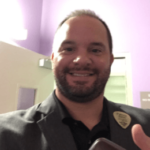The Grand Transition

Deciding to transition into a new career field can be paralyzing. The thought of learning new skills, meeting new people, or working in a new environment is overwhelming. Our brains are wired for safety. It’s this “wiring” that stops us from venturing into new realms of possibilities. We would rather drag through our daily grinds than start something new.
By Patrick Bellot
I too, was paralyzed by the idea of transition. For 14 of my 16 year gaming career, I was content and blissfully unaware of the amazing opportunities the world had to offer.
After my second daughter was born, I woke up from my safe slumber. I started fiercely searching for a career that would feed my soul. That’s when I stumbled upon software programming.
I must admit, at first, the idea wasn’t sexy. I mean, “who want’s to program a computer in binary?” That was my first and last wrong assumption. I very soon realized that was not the case. Software programming became a sexy beast.
I had a fondness for Apple products. That’s when the light of brilliance blinded me. “I WILL WRITE SOFTWARE FOR iOS!” (*angels singing*). Now, where do I start?
Without a Mac, I had to start somewhere. As luck would have it, Apple just introduced this new slick programming language at the WWDC ‘14. It was called Swift. (*que angels*) Apple also released The Swift Programming Language ebook for free download. That’s where I started.
In February of ‘15, I was able to purchase my very first MacBook Air. It was meant to be. After finishing the ebook, I began to search projects on YouTube and watching the Stanford course on iTunes U. At the end of August, I enrolled in the Udacity Nanodegree for iOS. The Udacity course is what I’m currently working through.
During my online course, I’ve also been creating an online presence. Creating an online presence, from many resources, is crucial to building credibility and establishing employability. Beginning a blog, sharing on multiple social media platforms, and maintaining a Github account are all ways to strengthen an online presence.
My second blog, www.swift-file.com, has been a fantastic outlet to share information about my journey into iOS/Swift development. I’ve also have created some very meaningful relationships with @hanning_thomas, @BaselNotBasil, and @JStheoriginal and others on Twitter. My Github account is where I share my course work with the world.
Putting the Puzzle Together
Great story! What does it mean for me? I want to do something else with my career but it would cost a lot.
Start by putting away all excuses! Put them in an envelope and ship them to the Arctic. Excuses will veil the real answers and truths.
Next, find the resources. You will be surprised what you can find with a couple of keystrokes on the computer. The internet is blooming with information on every topic you can imagine. All one has to do is login and search. Whether you are on a computer or mobile device, resources are there! With a little effort, your next career is at your fingertips.
If there is limited or no internet access, go to the local library. Resources can be found there also. Prioritizing research will place you into the fast lane and effort will be the gas petal.
Thinking of becoming an iOS developer, too? This is the roadmap I have been using with success. I’m not at the finish line yet. There is still more roads to travel on my journey. With a strong goal in mind, I’m closer than I was a year ago. I continue to enjoy this amazing adventure. Working daily toward my goals is the gasoline in my engine.
Here’s a few steps that have worked for me:
- Read The Swift Programming Guide by Apple. It’s free in iBooks.
- Find blogs and books about iOS development
- Buy a Mac. A Mac can be purchased through www.apple.com or a nearby Apple store. If there is a budget, Apple has a refurbished section on www.apple.com or find a deal on www.ebay.com. Be sure the Mac has the latest operating system. Only the Mac can run Xcode, which is Apple’s software development kit (SDK). Xcode is the program needed to build software for Apple.
- Watch YouTube videos for iOS development and the Stanford courses on iTunes U.
- Create an online presence with a blog, social media, and Github.
- Find a mentor. Someone who is already developing for iOS. If you live in the Bermuda Triangle of Tech like I do, then join Twitter. Connect and engage with developers. The camaraderie shared by developers is fantastic. There are many industries in the world but very few exhibit this type of brotherhood.
- Enroll in an online course. (optional: You may have enough knowledge or mentorship to help you with your development endeavors). I picked Udacity. After the course is completed, I’ll have 5 portfolio worthy projects to show off
- Create an app for the AppStore (a developer account is needed) or contribute to open source projects. This is my next step. Either of these options will grant the opportunity to a) attract employment or b) become an independent developer. The choice is yours.
Finally, remember that we, as developers, are problem solvers. Our responses to our users, is to create software that will help them to succeed. Couple this ideology with helping other developers in need, and you will be on your way to becoming a successful iOS developer.
[thrive_text_block color=”blue” headline=”About the guest author”]

Patrick Bellot is an aspiring iOS/Swift developer. A loving husband and father. Enthusiastic about Swift and all things nerdy. Follow him on Twitter @pbellot or www.swift-file.com.
[/thrive_text_block]
References
Title Image: @ hxdyl / shutterstock.com